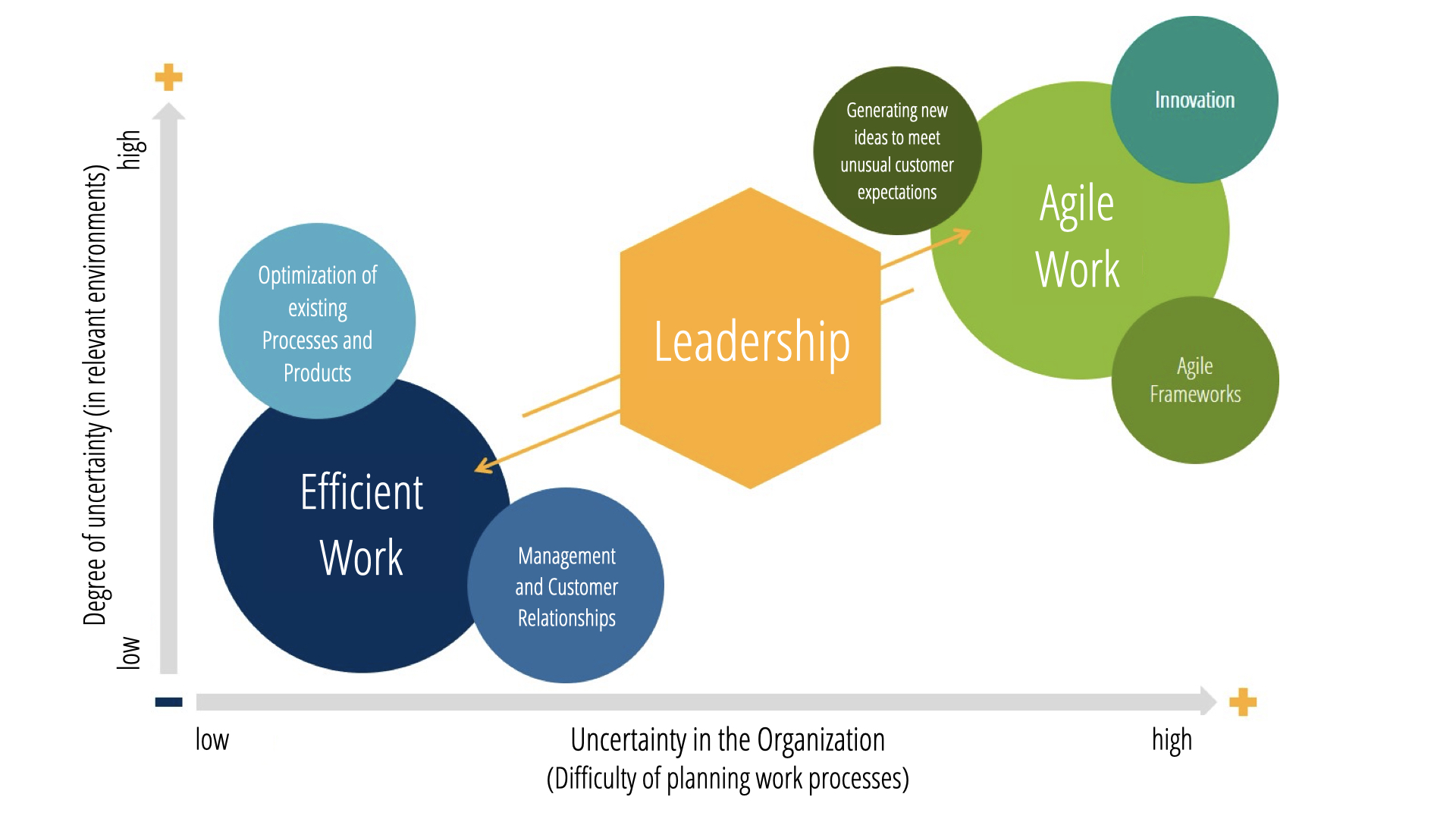Organizations need to constantly renew and update their product and service portfolio. This is nothing new. What is new, however, is the speed at which this needs to happen – because digitalization, complex dynamics, and the increasing opacity of markets have greatly accelerated innovation cycles in recent years. Organizations are challenged to develop new and creative solutions in the face of fierce competition in order to continue to meet the needs of their customers.
Find out how you can succeed in developing innovation and core business simultaneously in an online dialog with our systemic organizational consultants.
Organizations need to constantly renew and update their product and service portfolio. This is nothing new. What is new, however, is the speed at which this needs to happen – because digitalization, complex dynamics, and the increasing opacity of markets have greatly accelerated innovation cycles in recent years. Organizations are challenged to develop new and creative solutions in the face of fierce competition in order to continue to meet the needs of their customers.
Find out how you can succeed in developing innovation and core business simultaneously in an online dialog with our systemic organizational consultants.
Organizational Ambidexterity
Ambidexterity (from Latin: ambo – both; dexter – right, i.e. “ambidexterity”) describes the organizational ability to simultaneously efficiently manage and continuously optimize today’s business (“exploitation”) and, on the other hand, to recognize potential and develop innovations (“exploration”).
This ability is also referred to as organizational ambidexterity. As the name suggests, it cannot be mastered single-handedly. The reason for this is the challenge to reconcile two completely different basic logics.
While the core business and its further development usually follow clear structures, standardized routine processes and classic operating methods, innovative work requires more freedom – for this, start-up-like structures, often characterized by agile designs and iterative processes, prove to be particularly productive.
How ambidexterity is made possible - contextual and structural ambidexterity
These two very different basic logics do not work in parallel – at least not without proper management. Those who optimize routine processes hardly succeed in mentally detaching themselves from the established structures. Those who research and explore new business opportunities are often thwarted by rigid structures designed for efficiency.
- Contextual Ambidexterity
Contextual ambidexterity combines exploitation and exploration within a unified structure. An example of this is Google, whose employees invest 20 percent of their working time in innovative topics away from day-to-day business. However, both strands need to be managed wisely by leaders. - Structural Ambidexterity
Structural ambidexterity is made possible by an organizational, and often also spatial, separation that allows simultaneous processing of exploitation and exploration. This is done, for example, by creating separate organizational units, each focusing on one of the two strands.
Both approaches place great demands on managers. Regardless of which path they choose, they must manage the two different basic logics and the resulting paradoxes intelligently and constructively.
Ambidexterity in leadership - managing the emerging paradoxes
In addition to implementing appropriate structures, it is important for managers to link the different strands in such a way that they can become effective.
For example, if the explorative strand works in isolation and without consideration of organizational opportunities, it can add little value to the organization – feedback is needed to work together toward the organization’s future viability. Likewise, there is a need to sensitize the exploitative strand, which is often subject to rigorous processes and, in some cases, austerity measures, to the fact that the resources provided to the exploratory strand are wisely invested. The areas of tension that arise here should not be underestimated.
Leaders are challenged
- to ensure the transfer of knowledge between the two strands,
- to hand over responsibility where it makes sense and is necessary, and to trust the employees,
- give both strands the space and guidance they need to do their work.
Why ambidexterity is so important
Ambidexterity cannot be achieved in the blink of an eye and poses numerous challenges for the organization, its managers, and its employees. Why is it still worth the effort?
Organizations have a tendency of repeating past patterns of success. But at a certain point, these are no longer the right solution to the current problem. Framework conditions change and small adjustments made in previous years or even decades are no longer sufficient. Completely new routines, processes, ways of working or strategies are needed in order to be able to continue as an organization.
Yesterday’s solutions are today’s problems,
today’s solutions are tomorrow’s problems.
– Clare W. Graves
US-American psychologist

Ambidextrous organizations find it easier to recognize this point early on and adapt to it with innovative solutions.
Organizations that succeed in creating ambidexterity usually have some advantages over other organizations:
- They are more competitive because they are active in existing markets and also enter into new markets
- They are more adaptive, because the creation of ambidexterity is usually accompanied by structural adjustments that strengthen the adaptive capacity of the organization
- They ensure effective knowledge and information transfer, as the two strands of exploitation and exploration must be well linked to have full effect
- They teach their leaders to think ahead, as ambidextrous leaders always keep an eye on shaping the future. In addition, ambidextrous leaders turn into helpful impulse generators for the need for change in the organization
- They develop a modern, innovative corporate culture in which mistakes and breaking new ground are seen as learning opportunities, and provide space for creative thinking
- They are more characterized by trust, as employees take responsibility, especially in the exploratory strand, while managers learn to let go of the reins
Further information
On our website, you will find further information and corresponding consulting and service offers that will help you to establish structures and routines in your organization that enable and promote organizational ambidexterity:
Further Information on Ambidexterity

For more information about ambidexterity and agility, download our digital presentation.
CONTACT OPTIONS
If you would like to learn more about us and our consulting approach, we look forward to a personal conversation with you! Simply make an appointment with us.

Online
Make a non-binding inquiry and let us know your expectations in this way
 Frédéric SedlákSenior Consultant | HR Management
Frédéric SedlákSenior Consultant | HR ManagementWe are always at your service+49 4102 69 93 22
Ask for free informationf.sedlak@spconsulting.de










